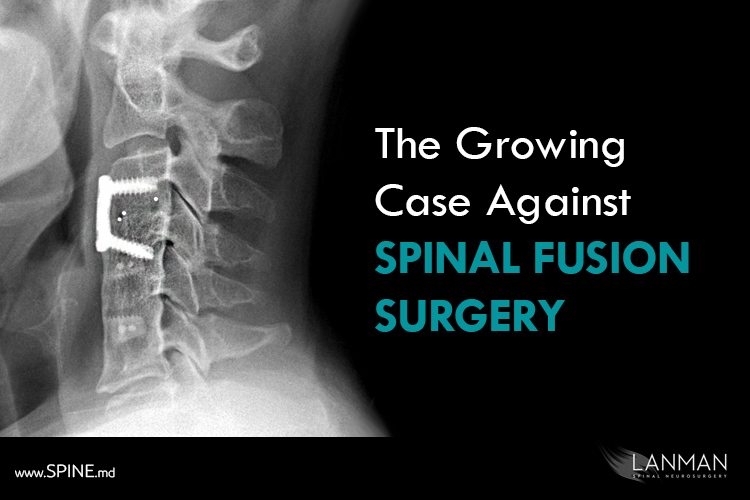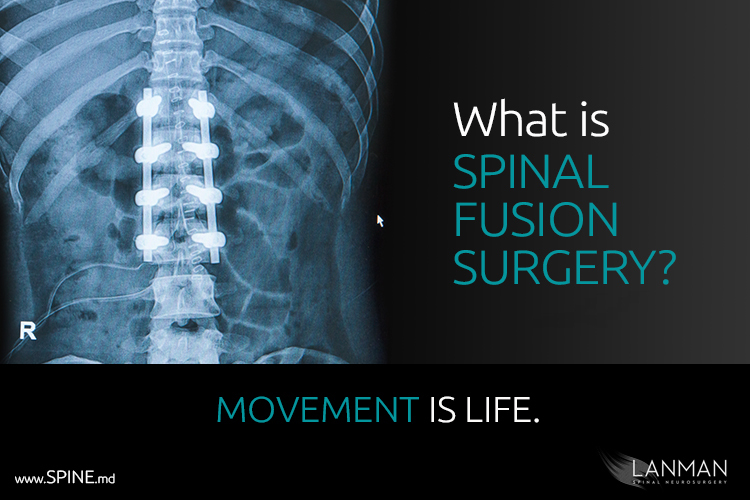From increasing anxiety and depression to just interfering with your ability to enjoy watching football with your family, back pain can prevent you from living a full life. Whether you’re experiencing unexpected twinges or prolonged pain, these symptoms can limit your ability to work and even sleep. Luckily, you don’t have to give up your favorite activities or put your life on hold because of back pain, there are multiple treatment options available to discuss with your spinal specialist.
One option your doctor may discuss with you is spinal fusion surgery. They may recommend this procedure if non-surgical methods (like physical therapy and hot or cold compresses) don’t work. The best way to make an informed decision as a patient is to know your options and better understand what this surgery entails. Learn more about spinal fusion surgery – and whether or not it’s worth it.
What is Spinal Fusion Surgery?
Spinal fusion surgery is an operation that fuses two or more vertebrae in your back. It can be completed in your cervical spine (your neck, shoulder, and upper-back area) or in your lumbar region (lower back).
Your vertebrae all work together to help you move. If you had a single bone in your spine, you wouldn’t be able to easily bend over, dance, and move your body. Each of these vertebrae is protected by a small, rubbery cushion called a spinal disc. These discs work as shock absorbers and allow people to move without pain. When these discs break, wear out, or get pushed out of place, the affected vertebrae knock against each other, which is where spinal fusion comes in.
Spinal fusion removes the damaged discs and connects the two damaged vertebrae together. Because they are fused into one bone, they no longer knock together and cause pain. Patients can experience reduced levels of back pain after spinal fusions surgery both because of the corrected vertebrae and because the damaged disc has been removed. If a spinal disc is pushed out of place, it can hit the nerve endings in your back, so removing the disc during spinal fusion eliminates this nerve pressure.
How is Spinal Fusion Done
Your spine is a complex part of your body, which means your doctor will have to take a targeted approach to your operation. They will develop a unique plan for the incision, removal of damaged discs, and the fusion of the spine. However, there are a few common steps that most doctors follow.
This operation is completed under general anesthesia, which means you will not be awake during the procedure. It will take a few hours and then you will move to the recovery room.
The doctor will choose the best method of entry based on the bones. They can either make the incision in your back and approach the spine directly or they can enter through your neck or abdomen. This latter option allows your surgeon to avoid the nerve canal in your back.Your doctor will remove any damaged material or problematic bone elements from your spine. This can include damaged spinal discs, bone grafts, and even parts of the lamina.
The doctor will then replace any removed spinal discs with a bone graft material that will fuse your vertebrae together. This material can either be taken from your body (usually from the pelvis) or made of artificial substances.
After the bone graft material is in place, the doctor will fuse the two vertebrae with screws, metal plates, or rods depending on the needs of the patient.
After the spine is properly fused, the operation is over. The surgeon will close the incision and the patient can start the recovery process.
Researchers Continue to Develop More Effective Fusion Methods
Doctors are working continuously to improve patient outcomes, and that means changing how spinal fusion is performed. Today’s surgeons use modern technology, new techniques, and cutting-edge methods to improve the results of spinal fusion surgery.
Studies show that the average spinal fusion surgery lasts 306 minutes (just over five hours). However, a new method developed by NYU Langone Health reduced the surgery to 103 minutes (less than two hours). Historically, spinal fusion patients would have to be repositioned during the surgical procedure so the doctor could thoroughly repair their spine. This was called the “flip” method as patients would need to be flipped over. The new process allows surgeons to complete the operation with the patient in one position – on their side.
Studies show this singular position not only reduces operating time, but it also leads to better outcomes in the spinal fusion operation. It makes the procedure less invasive and reduces the chances of complications. These factors also reduce the chance of infection post-operation and speed up the patient’s recovery time. As long as doctors continue to explore better ways to treat back pain, spinal surgery will continue to become safer and less invasive over time.
Outcomes Due to Spinal Fusions
Overall, spinal fusion has a high success rate. Doctors report success rates ranging from 70% to 95% depending on the procedure type and technology used. These odds often encourage patients who might be wary about undergoing a surgical procedure. The less invasive the procedure, the greater the chances of a successful surgery and a speedy recovery.
Spinal fusion outcomes will vary from patient to patient and not every patient will live a completely pain-free life after they recover from the operation. They may need to take occasional medications for the pain or continue with non-surgical treatment. However, many of these patients still report significant drops in their pain levels and share that they are able to work again or enjoy their favorite hobbies. Whereas the pain was unbearable before, it is reduced to a manageable level now.
When you meet with your doctor, ask about your spinal fusion outcomes, such as whether you can expect to live a pain-free life and keep your mobility. You can even ask about other operations, like artificial disc replacement after fusion. They should be able to provide honest answers about what your life will look like after surgery.
Understanding Spinal Stenosis
Spinal stenosis is one of the main conditions that lead to spinal fusion surgery. Your doctor may recommend a fusion operation if the stenosis starts to interfere with your day-to-day life. Spinal stenosis occurs when the space in your backbone isn’t large enough to support your nerves, vertebrae, and spinal discs. For example, the growth of a bone spur can push into the spinal canal, hitting nerves that lead to pain and numbness throughout the body. Tumors, herniated discs, and spinal injuries can all cause spinal stenosis.
Spinal fusion treats this condition by reducing pressure in your spine. Your surgeon might remove the herniated disc that is pushing into your nerve canal and then fuse the two vertebrae together. The goal of this procedure is to protect your nerves while preventing your spinal stenosis from worsening and causing more pain.
Spinal Instability
Another condition where spinal fusion is useful is spinal instability. This condition leads to hypermobility in the spine, to the point where spinal discs can’t provide protection. These cushions are built to handle specific types of movement at certain angles. When someone with spinal instability bends or twists, the discs can break or start to degenerate. People with spinal instability can also develop bone spurs, arthritis, or herniated discs when the cushions get pushed out of place.
In this case, spinal fusion increases stability. The patient benefits from a reduced range of motion because the vertebrae are fused together. They may have more control over their movements and are at reduced risk of developing additional complications that cause pain.
What to Expect from Fusion Surgery
In the event that your doctor recommends spinal fusion surgery, you can take steps to prepare for the operation and recovery. Because this surgery can be done in a few hours, it may be considered an outpatient procedure. You will need someone to bring you to the operation and pick you up when it’s complete.
The first few days after the operation are exclusively for recovery. Avoid bending, twisting, driving, or lifting anything more than eight pounds – which is around a gallon of milk. Your doctor will provide you with recommendations on how to sleep, walk, and manage the pain. By following these directions, you can increase your chances of a positive outcome and reduce your risk of infection.
After the first week, you should start to heal. You can move to lighter medication options and start to walk in order to increase muscle strength. You will need to avoid excessive listing (another more than 10 pounds) for at least the first month after the operation. During this time, attend follow-up appointments with your doctor to check on your healing progress and learn how to recover.
The total recovery time for your spinal fusion surgery could take more than three months. Your doctor will advise you on whether you can work, what you can lift, and how you can move. Take your time with recovery. The more you try to rush the healing process, the greater the strain you put on your body. Give yourself time to heal in the short run so you will be healthier in the years to come.
You Don’t Have to Live in Pain
One of the best ways to decide whether spinal fusion surgery is worth the risk is to weigh the consequences of delaying it. If you currently live in pain right now, there is a chance that it will get worse in the coming months, and you risk losing more of your mobility and feeling less comfortable doing basic activities. It is unlikely that you will recover on your own and the sooner you seek treatment, the better your chances of success. The opportunity to live without pain makes spinal fusion worth it.
If you currently live with back pain, get help today. Reach out to Dr. Todd H. Lanman at the Artificial Disc Replacement Spinal Restoration Center. Dr. Lanman is one of the top spinal surgeons in the country and, after a comprehensive consultation on your unique case, can recommend the right treatment for you, from spinal fusion to disc replacement, or other treatments based on your needs, like cervical disc replacement vs. fusion. If you’re ready to take the first steps toward treatment – and living life without back pain – call Dr. Lanman today.
Request a consultation online. Dr. Lanman is currently taking appointments in his Beverly Hill, Miami, and Palm Beach offices.






